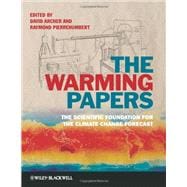
What is included with this book?
Ray Pierrehumbert is the Louis Block Professor in Geophysical Sciences, a Fellow of the American Geophysical Union, and was named Chevalier de l'Ordre des Palmes Academiques by the Republic of France. Pierrehumbert studies the physics of climate, especially regarding the long-term evolution of the climates of Earth, Mars.Venus, Titan and extrasolar planets. Pierrehumbert was an author of the Intergovernmental Panel on Climate Change's Third Assessment Report (1997-2001), and a member of the National Research Council's Panel on Abrupt Climate Change and its Societal Impacts (2000-2001), and is currently serving on the National Research Council Board on Atmospheric Science and Climate, and the National Research Council Panel on CO2 Stabilization Targets.
| Preface | |
| Climate Physics | |
| The Greenhouse Effect | |
| On the Temperatures of the Terrestrial Sphere and Interplanetary Space Jean-Baptiste | |
| Wagging the Dog | |
| On the Absorption and radiation of Heat by Gases and Vapours, and on the Physical Connexion of Radiation, Absorption, and Conduction | |
| By the Light of the Silvery Moon | |
| On the Influence of Carbonic Acid in the Air upon the Temperature on the Ground | |
| Radiative Transfer | |
| The Influence of the 15¿ Carban-Dioxide Band on the Atmospheric Infra-red Cooling Rate | |
| The Balance of Energy | |
| Thermal Equilibrium of the Atmosphere with a Given Distribution of Relative Humidity | |
| The Effect of Solar Radiation Variations on the Climate of the Earth | |
| A Global Climatic Model Based on the Energy Balance of the Earth-Atmosphere System | |
| The Birth of the General Circulation Model | |
| The Effects of Doubling the CO2 Concentration on the Climate of a General Circulation Model | |
| Climate Sensitivity: Analysis of Feedback Mechanisms | |
| Aerosols | |
| Climate Responnse to Increasing Levels of Greenhouse Gases and Sulphate Aerosols | |
| Ocean Heat and Committed Warming | |
| Earth's Energy Imbalance: Confirmation and Implications | |
| Taking Earth's Temperature | |
| Global Temperature Variations Between 1861 and 1984 | |
| Contribution to Stratospheric Cooling to Satellite-Inferred Troposphoric Temperature Trends | |
| Northern Hemisphere Temperatures During the Past Millennium: Inferences, Uncertanties, and Limitations | |
| Ice Sheets and Sea Level | |
| Surface Melt-Induced Acceleration of Greenland Ice-Sheet Flow | |
| The Public Statement | |
| Man-Made Carbon Dioxide and the 'Greenhouse' Effect | |
| Carbon Dioxide and Climate: A Scientific Assessment | |
| Carbon Cycle | |
| The Sky is Rising | |
| The Artificial Production of Carbon Dioxide and its Influence on Temperature | |
| Denial and Acceptance | |
| Carbon Dioxide Exchange Between Atmosphere and Ocean and the Question of an Increase of Atmospheric CO2 During the Past Decades | |
| Distribution of Matter in the Sea and Atmosphere: Changes in the Carbon Dioxide Content of the Atmoshere and Sea due to Fossil Fuel Combustion | |
| Bookends | |
| The Concentration and Isotopic Abundances of Carbon Dioxide in the Atmoshpere | |
| Is Carbon Dioxide from Fossil Fuel Changing Man's Environment? | |
| One if by Land | |
| Changes of Land Biota and Their Importance for the Carbon Cycle | |
| Observational Constraints on the Global Atmospheric CO2 Budget | |
| Acceleration of Global Warming due to Carbon-Cycle Feedbacks in a Coupled Climate Model | |
| Two if by Sea | |
| Neutralization of Fossil Fuel CO2 by Marine Calcium | |
| Effects of Fuel and Forest Conservation on Future Levels of atmospheric Carbon Dioxide | |
| Abrupt Deep-Seas Warming, Palaeoceanographic Changes and Benthic Extinctions at the End of the Palaeocene | |
| Ocean pH | |
| Anthropogenic Carbon and Ocean pH | |
| Reduced Calcification of Marine Plankton in Response to Increased Atmospheric CO2Ulf Riebesell | |
| Tiny Bubbles | |
| Evidence From Polar Ice Cores for the Increase in Atmospheric CO2 in the Past Two Centuries | |
| Vostok Ice Core Provides 160,000-Year record of Atmospheric CO2 | |
| Index | |
| Table of Contents provided by Publisher. All Rights Reserved. |
The New copy of this book will include any supplemental materials advertised. Please check the title of the book to determine if it should include any access cards, study guides, lab manuals, CDs, etc.
The Used, Rental and eBook copies of this book are not guaranteed to include any supplemental materials. Typically, only the book itself is included. This is true even if the title states it includes any access cards, study guides, lab manuals, CDs, etc.